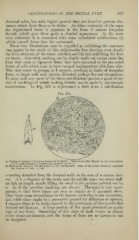Page 867 - My FlipBook
P. 867
CALCIFICATIONS OF THE DENTAL FULP. 877
dentinal tubes, but with higher powers they are found to present cha-
racters which show them to be fliults. At either extremity of the mass
the degenerated tissue is apparent in the form of minute irregular
threads Avhich give these parts a clouded appearance. At the root-
wise extremity it is connected with some cylindrical calcifications {e)
which extend down into the root-canal.
These two illustrations may be regarded as exhibiting the extremes
that appear in the study of this subject—the first showing most clearly
the form-elements of the tissue calcified, and the last exhibiting the few-
est traces. Generally, nothing can be clearly made out except some fine
lines that seem to represent fibres that have persisted or the perverted
forms of cells which seem to have escaped impregnation with lime salts.
This may occur in groups, as I suppose, resulting in faults of irregular
form, or single cells may remain, distorted perhaps beyond recognition.
In some such Avay most of the tissue-calcifications possess a great diver-
sity of markings of which nothing definite can be made by microscojjic
examination. In Fig. 473 is represented a field from a calcification
Fig. 473.
A, Outline of Incisor, with crown destroyed by decay. There is a calcific deposit in the root portion
of the pulp-chamber | inches long, pointed out by a.
B, Illustration showing the characters of the calcification. Some of the forms resemble somewhat
the lacunae of boue (X ti50).
occurring: detached from the dentinal walls in the root of a carious inci-
sor. A is a diagram of the tooth, and the calcific mass was about half
an inch in length, nearly filling the canal in the position pointed out by
a. In B the peculiar markings are shown. The mass is very ti-ans-
])arent, so that these forms are seen as clearly as if mounted alone.
They have some resemblance to the lacunae occurring in the cementum,
and, while there might be a reasonable ground for difference of o])inion,
I suppose them to be faults formed by the persistence of tissue-cells that
resisted calcification. A large portion of this mass presented no mark-
ings of any kind. Something of this class oi fault occurs in almost
every tissue-calcification, and the forms of them are as various as can
be imao;ined.


